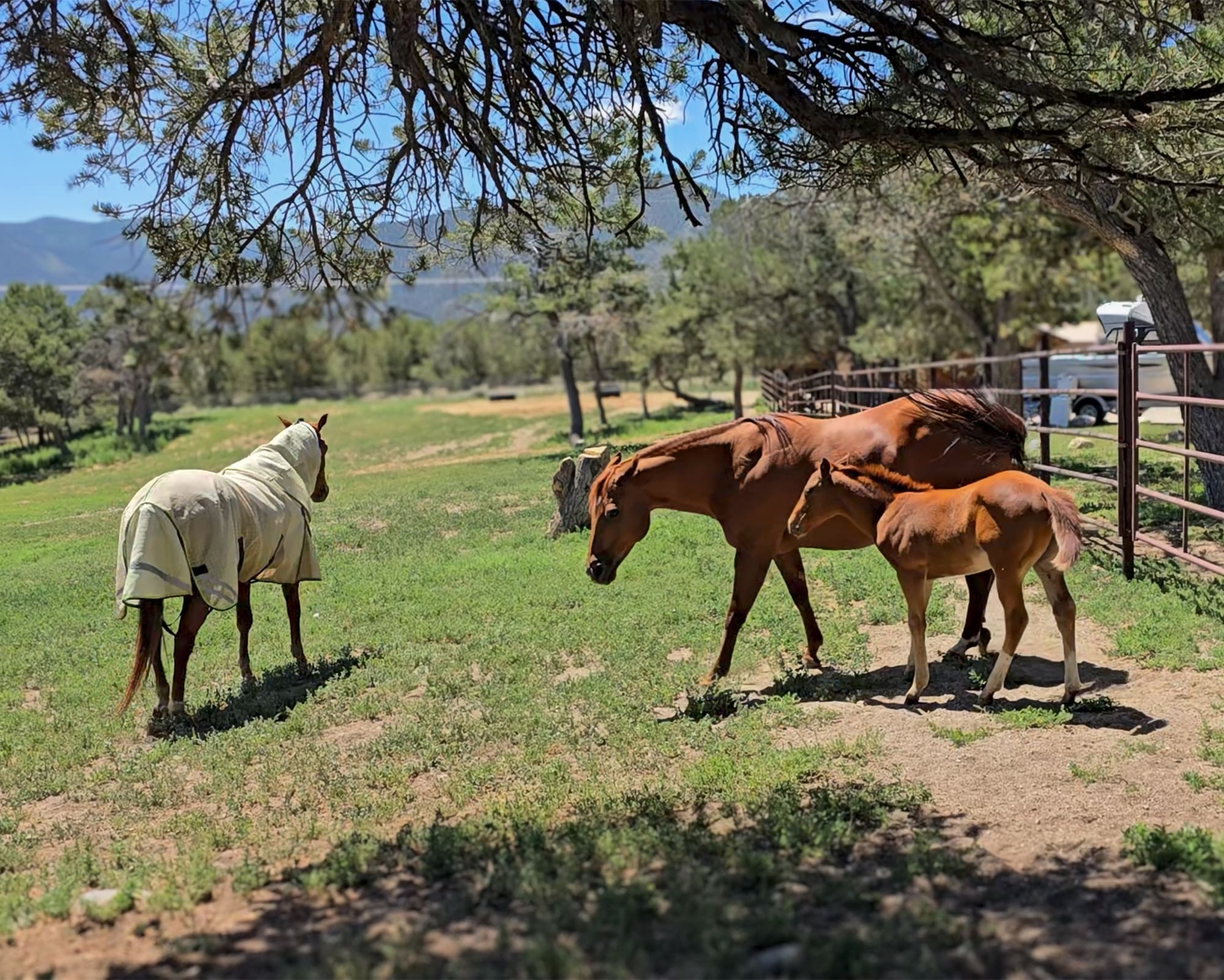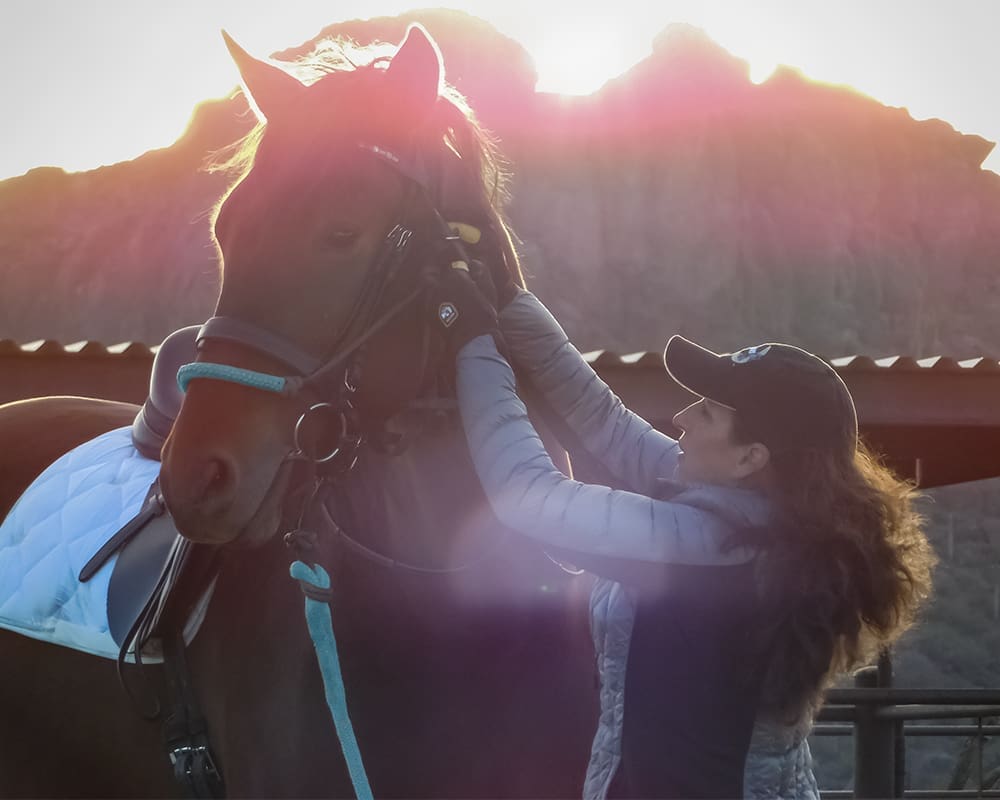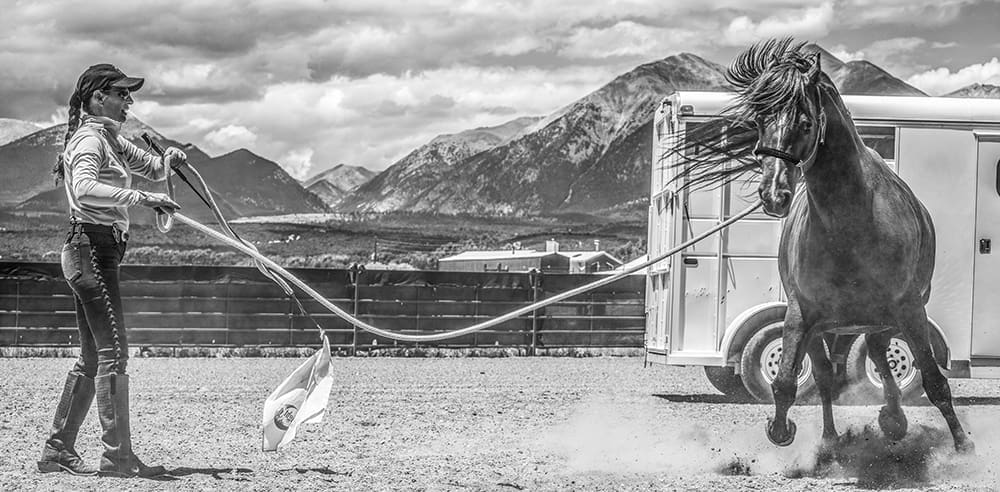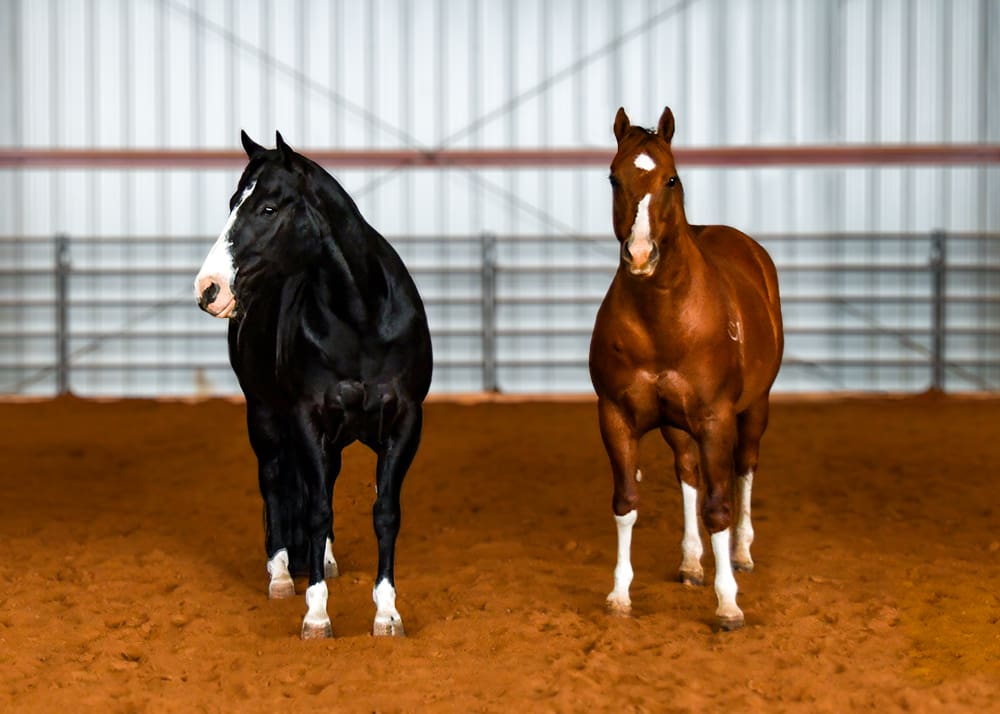
It should go without saying that training and riding a thousand-pound flight animal is complicated—it’s the only sport I know of that involves inter-species teamwork. Riding is a partnership of two athletes—horse and human—each with their own balance, emotionality, and willfulness. Learning to ride a horse confidently and securely with finesse and poise in all situations can take years, if not decades, to master.
Aside from heels up and hands too high, looking down is one of the most common errors I see riders make, regardless of their riding discipline or experience level. Riders everywhere tend to focus down on the horse’s neck as they ride—when they are thinking too hard, nervous, concerned about the horse, learning, or concentrating on something new.
If you think about it, how well you use your eyes is critical in most athletic endeavors, especially those involving balance and movement, like horseback riding. If balance, accuracy, and focus are needed to win the game, your eyes are your secret weapon.
Learning to keep your eyes level and softly focused on a distant target is critical to your balance, whether you are riding a precise pattern on a horse, executing a floor routine in gymnastics, or riding single-track on a mountain bike. Having a soft, far-off focus when riding helps you stay in balance with the horse and know where you are going.
Turning with Your Eyes
Horses communicate primarily with gestures and postures They are herd animals that react to the focus and emotions of their herd mates—if one horse suddenly turns its head and gazes off in the distance, all the horses will turn their head to look. It’s an instinctive trait of survival.
Handling a horse from the ground, using your eyes and body language appropriately communicates the direction you want the horse to go and your confidence and authority as the leader. Communicating intentionally with your eyes may mean glancing in the direction you want the horse to turn, averting your gaze when you want the horse to come to you, or staring it directly in the eyes if you want to drive the horse forward or establish boundaries.
Sitting atop the horse, with a great deal of connectivity through your seat, legs, and hands, using your eyes deliberately when you want to turn or go straight, sends directional cues to the horse.
Right now, sit up straight in a chair, with your feet underneath you, equal weight on two seat bones, shoulders over your hips, abs engaged, chin up and eyes level. Imagine a Marionette string at the top of your head, lifting you up, lengthening your spine, centering your weight. This is the balanced position we aim for on the horse.
Now imagine you have a neck brace and body cast on, and the only way to look to the right is to slowly twist your shoulders and torso. Feel the changes in your body, from your head all the way down to your feet. Just by simply looking in the direction you want to go, the horse receives the correct turning cues from your seat, legs and hands.
Horses communicate within the herd through glances, gestures, and focus. When riders use their eyes deliberately, consistently and with meaning, the horse learns to rely on the rider’s eyes for communication too.
The Mind, Body, Spirit Connection
Because the mental, physical, and emotional states of our being are interconnected, you cannot have a thought without having a physical reaction. Famously, this is what we mean by “thinking a horse into the canter.” To the sensitive, high-energy horse, the rider merely thinks about the motion, which causes minute changes that the sensitive horse receives as a cue to go.
There is also a connection between your physicality and your emotions. It is not hard to know if a person is sad, angry, or frightened, just by looking at their body language. The reverse works as well! It has been proven by science that when people put themselves in certain confident-looking postures, they feel more confident. Try the Superman pose and see how you feel.
On the contrary, when negative emotions like fear and frustration take root, riders tend to stare down at their hands, shutting down focus. The simple act of looking up and focusing on the environment around you, engages your mind and body in a positive direction and keeps negative emotions in check.
Because horses are so adept at reading body language and adopting the emotions of the animals around them, using your eyes to show confidence and assuredness can have a calming influence on your horse. In the presence of a human that looks confident and in-charge, the horse is less likely to challenge authority. All that starts with your eyes.
The Enemy
If consciously using your eyes to communicate direction, confidence, and determination are your super-powers, then looking down at the horse’s neck is the Kryptonite that drags you down. We’ve established that in most sports, what you do with your eyes is important, sometimes critical. But with riding, it not only erodes your communication, confidence, and authority with the horse, it also has negative effects on the horse’s athletic performance.
Horses are naturally heavy on the forehand, yet all their power comes from behind—it’s like a 2-wheel-drive pickup in the snow. When riders focus down at the horse’s neck, it automatically brings their weight forward, weighting the forehand even more.
To rebalance the horse onto its hindquarters for more power and athleticism (aka collection), the rider must first look up and find the balanced (vertical) position, engage her core, elevate the forehand and drive the hind-end up underneath the horse. Looking down makes all that impossible.
Another negative side-effect of looking down is that the riders gets their shoulders in front of their hips, closing the pelvis joint and losing range-of-motion. This leads to tension in the hips and bouncing on the horse’s back—what we fondly refer to as “butt slapping.” A hollowed back in the rider leads to a raised head and hollowed back in the horse.
Perhaps the most devastating effect on the horse’s performance that looking down causes is a loss of connection between horse and rider. Feeling the horse’s rhythm, centering yourself, finding an effortless balance with the horse, and communicating with finesse, will only happen when the rider’s eyes are up, with a far-off and soft focus.
The Eyes are the Window to Your Soul
Horses are exceptionally keen at reading and understanding the human’s confidence, intention, determination, and authority (or lack thereof). Often it is the person’s eyes that give them away— looking down, lost in thought, their brain shutting down, missing opportunities to connect. This is not the picture of confident leadership.
Around horses, we like to say, “Fake it ‘til you make it,” because even if you feel weak on the inside, you can fool your horse by looking up and displaying strong body language on the outside. These are acting skills that can hugely impact the behavior of a horse and your eyes are the key that unlocks that door.
A simple thing like looking where you are going (a good idea, since you are the one steering), instead of staring down at your hands, makes you feel more confident and indicates your intention. Looking confidently beyond a scary obstacle lets the horse know you are determined and confident to cross it, while staring directly at the scary thing may validate the horse’s fear.
Honestly, horses are more aware of the riders’ intention and determination than they are. Horses are masters at reading body language and your eyes and focus are dead giveaways. Keeping your eyes up, taking in information in the ever-changing environment and deliberately conveying your intention with your eyes will unleash your secret powers and propel your horsemanship to new heights.



